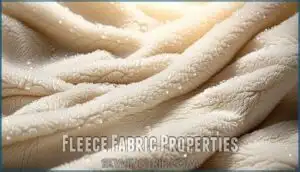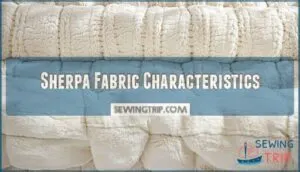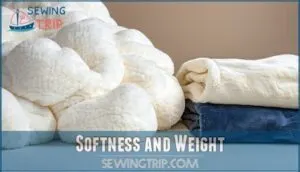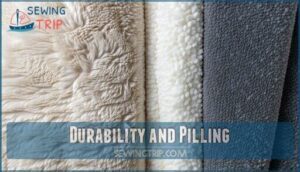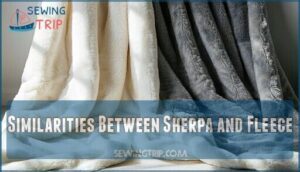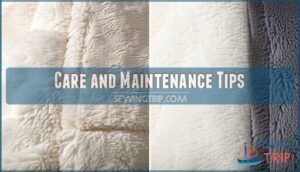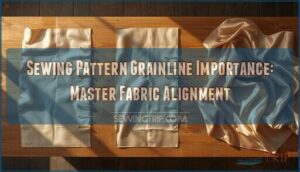This site is supported by our readers. We may earn a commission, at no cost to you, if you purchase through links.
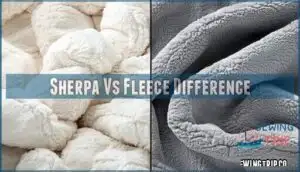 When you’re shopping for cozy fabrics, the sherpa vs fleece difference comes down to thickness and warmth.
When you’re shopping for cozy fabrics, the sherpa vs fleece difference comes down to thickness and warmth.
Sherpa’s got that fluffy, teddy bear texture with a bumpy pile that traps air like a warm hug, making it thicker and toastier than fleece.
Fleece feels smoother and lighter, perfect for layering without bulk, think of sherpa as your winter comfort blanket and fleece as your everyday go-to jacket.
Both are synthetic and easy to wash, but sherpa’s thicker construction can pill over time while fleece stays looking fresh longer.
Your choice depends on whether you need maximum coziness or everyday versatility, and the construction details reveal even more surprising differences, with sherpa and fleece having distinct uses, and considering the need for warmth and versatility is key.
Table Of Contents
- Key Takeaways
- What is Sherpa Fabric
- Sherpa Vs Fleece Difference
- Fleece Fabric Properties
- Types of Fleece Fabric
- Sherpa Fabric Characteristics
- Key Differences Between Sherpa and Fleece
- Similarities Between Sherpa and Fleece
- Choosing Between Sherpa and Fleece
- Uses and Applications of Sherpa and Fleece
- Care and Maintenance Tips
- Frequently Asked Questions (FAQs)
- Conclusion
Key Takeaways
- You’ll get more warmth from sherpa’s thick, fluffy texture – it traps air better than fleece’s smooth surface, making it ideal for cold weather blankets and jacket linings when maximum coziness matters.
- Fleece wins for everyday versatility and durability – it’s lighter, resists pilling better over time, and works perfectly for layering without bulk, making it your go-to choice for active wear and year-round comfort.
- Both fabrics are synthetic polyester that’s easy to care for – you can machine wash them in cold water and tumble dry on low heat, but skip fabric softeners since they’ll damage the moisture-wicking properties.
- Your choice depends on your specific needs – pick sherpa when you want maximum warmth for stationary activities like lounging, and choose fleece when you need breathable, lightweight comfort for outdoor adventures or athletic wear.
What is Sherpa Fabric
Sherpa fabric is a synthetic polyester material that mimics the soft, woolly texture of real sheepskin with its distinctive double-sided design.
You’ll recognize sherpa by its smooth knit exterior and fluffy, plush pile interior that traps heat effectively while remaining lightweight and breathable.
Sherpa wraps you in cloud-like warmth while fleece keeps you moving—both synthetic champions of cozy comfort.
Material Composition
You’ll find sherpa fabric breaks down to its core synthetic DNA: 100% polyester fibers engineered for maximum coziness.
This fabric origins story begins with polyester’s ability to mimic real sheepskin without the hefty price tag.
Here’s what makes sherpa material tick:
- Synthetic blends create consistent warmth and durability
- Recycled materials often form the polyester base, supporting sustainability
- Fiber types specifically chosen for their insulating properties
Plush Pile Texture
Beyond sherpa fabric‘s synthetic composition, you’ll immediately notice its signature plush pile texture that sets it apart from standard fleece fabric.
The sherpa texture creates an unmistakable tactile experience through its dense, fluffy surface.
| Feature | Sherpa Texture | Fleece Texture |
|---|---|---|
| Pile Height | Extra thick, fluffy | Smooth, low profile |
| Texture Variation | Bumpy, uneven surface | Consistent, uniform |
| Softness Perception | Cloud-like plushness | Silky smoothness |
This visual appeal makes sherpa irresistibly touchable, with a cloud-like plushness that enhances its appeal.
Moisture-Wicking Properties
Sherpa fabric excels at moisture-wicking through its unique double-layer construction. The smooth knit side moves sweat away from your skin, while the fluffy pile side allows quick evaporation.
This superior sweat management gives sherpa an edge over traditional fleece fabric in performance apparel. One key factor is that capillary action helps draw sweat away.
Here’s how sherpa vs fleece compares in moisture-wicking:
- Sherpa absorption – Dense pile traps moisture before it reaches your skin
- Fleece breathability – Standard fleece allows airflow but retains more moisture
- Drying speed – Sherpa’s structure promotes faster evaporation than regular fleece
- Performance apparel – Sherpa works better for high-intensity winter activities
- Breathability – Sherpa fabric maintains airflow while managing sweat effectively
Sherpa Vs Fleece Difference

When weighing sherpa vs fleece options, you’ll notice distinct differences that affect your comfort choices. Both fabrics share synthetic origins, but their construction creates unique experiences.
| Feature | Sherpa Fabric | Fleece Material |
|---|---|---|
| Warmth Level | Superior insulation | Moderate warmth |
| Weight | Heavier feel | Lightweight |
| Texture | Plush, fuzzy pile | Smooth surface |
Sherpa material delivers that "wrapped in clouds" sensation with its thick, fluffy texture mimicking real sheepskin. Fleece fabric offers versatility with moisture-wicking properties perfect for active wear. One key aspect is that fleece offers breathability due to its porous construction.
Cost comparison shows both materials remain budget-friendly, though sherpa typically costs slightly more. Environmental impact concerns apply to both synthetic options, releasing microplastics during washing. For ideal applications, choose sherpa for maximum coziness at home, fleece for outdoor adventures requiring breathability and quick-drying performance.
Fleece Fabric Properties
You’ll find that fleece fabric offers impressive insulation properties, trapping warm air within its synthetic polyester fibers while maintaining breathability for comfort.
This versatile material combines lightweight construction with moisture-wicking capabilities, making it an excellent choice for both indoor comfort and outdoor activities.
Softness and Warmth
While both fabrics promise comfort, fleece fabric delivers exceptional softness that makes you want to snuggle up immediately.
Your skin experiences gentle warmth retention without feeling suffocated or overheated.
Here’s how fleece fabric excels in comfort:
- Softness rivals cashmere without the premium price tag
- Fleece warmth provides consistent insulation comparison against sherpa thickness
- Fabric weights remain light while maintaining thermal efficiency
- Fleece breathability prevents overheating during active wear
Fleece fabric creates the perfect balance between sherpa warmth and everyday wearability for maximum comfort.
Lightweight and Breathable
Most fleece fabrics excel at Moisture Management while maintaining exceptional Air Permeability.
You’ll notice how fleece breathability keeps your Body Temperature regulated during various activities.
This lightweight champion won’t weigh you down like heavier alternatives.
| Property | Fleece | Cotton | Wool |
|---|---|---|---|
| Weight | Light | Heavy | Medium |
| Breathability | High | Low | Moderate |
| Moisture-wicking | Excellent | Poor | Good |
| Athletic Performance | Superior | Limited | Average |
Whether you’re choosing athletic wear or casual layers, fleece’s moisturewicking properties adapt to your Activity Level, ensuring ideal Comfort Level throughout your day.
Retains Softness After Washing
Beyond being lightweight and breathable, fleece fabric truly shines in the context of washing impact.
You’ll find that quality fleece maintains its signature softness through countless wash cycles, unlike sherpa fabric which can lose its plush feel over time.
The synthetic fibers resist fiber degradation remarkably well, whether you air-dry or use low heat, proper drying methods preserve that cozy texture.
For long-term care and softness comparison, fleece consistently outperforms sherpa fleece.
Types of Fleece Fabric
You’ll find three main types of fleece fabric when shopping for cozy clothing and blankets.
Each type offers different benefits, from polar fleece‘s thick warmth to microfleece‘s lightweight comfort and lycra-blend fleece’s stretchy fit.
Polar Fleece
This heavyweight champion of fleece fabric delivers extreme warmth through its thick, plush construction.
You’ll find polar fleece creates perfect standalone coats that handle brutal winters without extra layers.
Its synthetic properties and superior thickness levels make it ideal for outdoor performance.
Many retailers offer various polar options.
This durable fleece material offers unmatched insulation while maintaining breathability for active adventures.
Microfleece
You’ll love microfleece for its Lightweight Insulation without the bulk.
This thin polyester Performance Apparel champion offers superior breathability while maintaining warmth. Microfleece Softness rivals thicker alternatives, making it perfect for activewear that moves with you.
Microfleece Applications include:
- Athletic base layers for temperature regulation
- Hiking jackets that pack small
- Running gear requiring moisture management
- Travel clothing needing minimal luggage space
- Everyday wear balancing comfort and functionality
Washing Microfleece stays simple with cold water cycles.
Lycra-Blend Fleece
While microfleece offers lightweight comfort, lycra-blend fleece delivers superior athletic performance through enhanced stretchability.
This fleece fabric combines polyester with lycra spandex fleece for unmatched flexibility and comfort durability.
- Stretch Properties: Maintains shape after intense workouts
- Athletic Applications: Perfect for sportswear and activewear
- Blending Benefits: Quick-drying with excellent cost comparison value
Sherpa Fabric Characteristics
You’ll notice sherpa fabric stands out with its thick, fluffy texture that mimics real sheepskin, making it one of the warmest synthetic materials available.
This double-sided polyester fabric combines a smooth knit exterior with a plush, bumpy interior that traps heat effectively while staying lightweight and breathable.
Thickness and Density
Dense
Three key factors separate sherpa fabric from regular fleece: pile height, fabric weight, and material density.
Sherpa fleece delivers superior thickness with its 350-450 GSM comparison rating versus fleece fabric’s lighter 250-350 GSM.
This higher fabric weight creates better insulation levels, while sherpa’s dense construction traps more air pockets for enhanced warmth retention.
It was first produced in the 1970s as a synthetic wool alternative.
Softness and Plush Texture
Touch sherpa fabric and you’ll understand why texture comparison matters.
Feel the difference between ordinary and extraordinary – sherpa fabric transforms every touch into pure comfort bliss.
Its plush pile creates an extraordinary sensory experience that outshines regular fleece fabric.
The tactile qualities feel like brushing against clouds, while the plushness factor delivers unmatched comfort.
This fabric handfeel transforms sherpa fleece into pure luxury, making every touch a cozy embrace that regular materials simply can’t match.
Warmth and Insulation
Sherpa fabric’s heat-trapping prowess makes it your go-to winter warrior when cold weather strikes.
This dense material creates a cozy barrier that locks in body heat while maintaining breathability.
Unlike regular fleece fabric, sherpa’s unique two-sided structure maximizes insulation properties without adding excessive material weight.
The plush pile texture works like tiny air pockets, creating superior warmth retention that outperforms standard fleece thickness in most conditions.
- Superior heat retention through dense fiber construction and air-trapping technology
- Breathable insulation that prevents overheating while maintaining consistent warmth
- Lightweight warmth that doesn’t add bulk compared to traditional winter materials
- Wind-resistant barrier that blocks cold air penetration effectively
Key Differences Between Sherpa and Fleece
You’ll notice sherpa and fleece differ in three main areas: warmth capacity, texture quality, and long-term durability.
While sherpa provides superior insulation with its thick, plush pile structure, fleece offers lighter weight and better resistance to pilling over time.
Warmth and Thickness
When choosing between sherpa vs fleece for warmth, sherpa fabric delivers superior insulation with its thick, dense construction.
Fleece fabric offers moderate warmth while staying lightweight—perfect for layering options.
Climate suitability matters: sherpa excels in extreme cold, while fleece works across seasons.
Your activity level determines the winner—sherpa for stationary warmth, fleece for active pursuits.
Softness and Weight
Weight comparison reveals fleece’s lighter profile makes it perfect for layering without bulk.
Sherpa plushness creates a heavier, cloud-like embrace that wraps you in luxury.
Fabric softness varies between these textures – fleece offers smooth consistency while sherpa delivers fuzzy warmth.
Consider these texture differences when choosing:
- Fleece weight stays minimal for active wear
- Sherpa vs fleece softness favors sherpa’s plush feel
- Lightweight fleece wins for versatile fabric comparison needs
Durability and Pilling
Durability battles often come down to fiber strength and pilling causes.
Sherpa’s dense construction offers superior sherpa durability against abrasion impact, while fleece shows pilled fabric issues sooner.
Wash resistance varies between fabrics—sherpa maintains its plush texture longer.
Longevity factors include proper care and usage frequency.
Understanding fleece durability helps you choose wisely for lasting comfort.
Similarities Between Sherpa and Fleece
You’ll find that both sherpa and fleece share several key traits that make them popular choices for cozy fabrics.
Both materials offer easy machine washing in cold water, provide excellent comfort for blankets and clothing, and work well for various indoor and outdoor applications, making them ideal for cozy fabrics.
Comfort and Versatility
Discovering comfort in both sherpa and fleece means you’ll find versatile options for any situation.
Both fabrics excel in Everyday Use, adapting from casual lounging to outdoor adventures with remarkable ease.
Their softness and warmth make them perfect for Seasonal Comfort, shifting smoothly between spring evenings and winter days.
When considering sherpa vs fleece for comfort, both offer excellent Layering Options that suit different Activity Choice scenarios.
You can layer fleece under jackets for hiking or wear sherpa-lined hoodies for cozy nights.
Personal Preference ultimately guides your decision, as both fabrics provide consistent comfort across various temperatures and activities, making them reliable choices for your wardrobe’s foundation pieces.
Fleece, however, is known for absorbing odors quickly, which may impact long-term comfort.
Ease of Care and Maintenance
Beyond comfort and versatility, both sherpa and fleece shine in terms of everyday maintenance. You’ll love how these synthetic fabrics handle regular washing without losing their cozy appeal.
Here’s your simple care routine:
- Washing techniques: Use cold water and gentle cycle to prevent shrinkage concerns
- Drying methods: Tumble dry on low heat or air dry to maintain texture
- Pilling prevention: Turn garments inside out before washing
- Stain removal: Treat sweat stains promptly with mild detergent
Both sherpa care and fleece care follow similar guidelines. Skip fabric softeners since they can reduce moisture-wicking properties and trap bacteria. Never iron directly on these fabrics – the heat creates ironing risks that can melt fibers.
With proper washing techniques, your favorite pieces will resist pilling and stay fresh wash after wash.
Choosing Between Sherpa and Fleece
You’ll need to examine three main factors when selecting between sherpa and fleece: warmth requirements, budget constraints, and intended use.
Your choice depends on whether you prioritize maximum insulation for cold weather or prefer a lighter, more versatile fabric for year-round comfort.
Considerations for Warmth and Softness
Your warmth and softness needs determine which fabric wins.
Sherpa fabric delivers superior insulation with its plush texture, while fleece material offers breathable comfort for active lifestyles.
Consider your climate suitability – sherpa excels in freezing temps, fleece works for layering options.
- Snuggling up feels like heaven with sherpa’s cloud-like embrace
- Fleece keeps you cozy without feeling suffocated
- Cold mornings become bearable with proper insulation comparison
- Your skin deserves fabric that matches your texture preferences
Your fabric choice should prioritize breathable comfort, superior insulation, and plush texture to ensure the best fit for your lifestyle, whether it’s active lifestyles or relaxation.
Factors for Durability and Cost
Your budget matters when choosing between these cozy fabrics.
Sherpa’s superior Production Methods create longer Lifespan Expectancy, but higher sherpa cost reflects this quality.
Fleece cost stays budget-friendly, though fabric durability varies by Material Composition.
Cleaning Impact affects both fabrics differently – sherpa resists pilling better, while fleece may show wear faster with frequent washing.
| Factor | Sherpa | Fleece |
|---|---|---|
| Purchase Price | Higher upfront cost | Budget-friendly option |
| Durability Rating | Superior pilling resistance | Moderate wear resistance |
| Maintenance Cost | Lower replacement frequency | May need earlier replacement |
| Long-term Value | Better cost-per-wear ratio | Higher replacement costs |
| Care Requirements | Gentle washing needed | More washing-resilient |
Personal Preferences and Needs
Narrowing down your fabric choice comes down to what matters most to you.
Your personal preferences shape the perfect match between sherpa fabric and fleece lining options.
Climate considerations and activity level guide your decision, but your individual needs seal the deal.
- Climate considerations – Match fabric thickness to your local weather patterns
- Activity level – Choose breathable fleece for active pursuits or cozy sherpa for lounging
- Budget constraints – Balance quality with affordability for long-term satisfaction
- Sensory preferences – Consider how different textures feel against your skin
- Ethical concerns – Evaluate environmental impact and manufacturing practices
Your lifestyle determines whether you need maximum warmth or versatile comfort.
Some prefer sherpa’s plush softness for relaxation, while others choose fleece’s lightweight flexibility.
Trust your instincts about what feels right – your personal preference trumps any generic recommendation.
Uses and Applications of Sherpa and Fleece
You’ll find sherpa and fleece fabrics in different products based on their unique properties and performance needs.
Sherpa works best as jacket linings, winter coats, and cozy blankets because of its superior warmth, while fleece excels in athletic wear, outdoor gear, and lightweight clothing due to its versatility and breathability.
Winter Clothing and Accessories
Winter clothing demands smart layering strategies for ideal thermal regulation.
Sherpa fabric excels in jackets and coats, delivering superior warmth through its plush texture. Fleece lining works perfectly in gloves, hats, and scarves, offering weather resistance without bulk.
You’ll find sustainable options in recycled fleece pullovers and eco-friendly sherpa vests. Current accessory trends favor sherpa-lined boots and fleece neck gaiters.
You can find various styles available online. Choose sherpa for maximum insulation in winter garments, or fleece for active outdoor pursuits requiring breathability.
Home Decor and Bedding
Transforming your living space into a cozy retreat starts with choosing the right fabrics for your home.
Sherpa fabric and fleece lining create inviting atmospheres in any room.
Consider these factors when selecting blankets and throws:
- Blanket warmth – Sherpa offers superior insulation for cold nights
- Texture preference – Fleece blanket provides smooth, consistent softness
- Cost comparison – Both materials offer affordable comfort options
- Seasonal use – Layer different textures for year-round appeal
- Allergen concerns – Synthetic materials resist dust mites and pet dander
Sherpa’s popularity is due to its exceptional bedding warmth.
Smart fabric choices transform ordinary spaces into welcoming sanctuaries.
Outdoor Gear and Equipment
How does your gear perform when nature turns harsh? Your outdoor adventures require fabrics that won’t let you down when temperatures drop or winds pick up.
Sherpa fleece and regular fleece deliver exceptional performance in challenging conditions:
- Sherpa-lined sleeping bags provide maximum insulation for sub-zero camping nights
- Fleece base layers offer superior moisture-wicking during high-intensity hiking
- Layering systems combine both fabrics for adaptable weather resistance
Fleece performance shines in active pursuits, while Sherpa durability excels in stationary situations. Your backpack compatibility depends on weight preferences—fleece packs lighter, but Sherpa’s warmth-to-weight ratio impresses. Both fabrics handle outdoor activities beautifully, keeping you comfortable mile after mile.
Care and Maintenance Tips
Proper care makes all the difference in keeping your sherpa and fleece fabrics looking fresh and feeling soft for years.
You’ll need to follow specific washing rules and drying methods to prevent pilling, shrinkage, and texture damage that can ruin these synthetic materials, which is crucial for maintaining their quality and ensuring they remain soft.
Washing and Drying Instructions
Machine washing your sherpa and fleece requires careful attention to water temperature and dryer settings.
Always turn fabrics inside out before washing in cold water wash using a gentle cycle. Skip fabric softener—it damages moisture-wicking properties.
For detergent choice, use mild, liquid formulas that won’t harm synthetic fibers. When drying, select low heat dryer settings to prevent melting.
For stain removal, treat spots immediately with cold water before washing. These care tips protect your investment while maintaining the cozy comfort you love.
Avoiding Pilling and Damage
Nobody likes their cozy sherpa fabric or fleece looking worn and bumpy.
Gentle washing in cold water prevents fiber damage, while air drying keeps textures intact. Turn garments inside out before washing for fiber protection.
When pilling appears, use a depilling tool instead of picking at fuzz. Storage solutions matter too—fold loosely to avoid crushing fibers.
Skip fabric softeners during fabric care since they weaken synthetic materials. Pilling prevention starts with proper washing techniques.
Ironing and Steaming Precautions
Heat spells disaster for your cherished sherpa and fleece fabrics.
Never iron these synthetic materials directly—they’ll melt faster than ice cream on hot pavement. Instead, embrace gentler fabric care alternatives that preserve their cozy texture.
- Melting temperatures: Both fabrics melt around 250°F, making traditional ironing techniques extremely risky
- Steaming alternatives: Use low-heat steamers from 6+ inches away for wrinkle removal
- Damage prevention: Always test heat sensitivity on hidden fabric areas first
- Care tips: Air-dry completely before attempting any heat-based treatments
Frequently Asked Questions (FAQs)
What is the difference between Fleece and Sherpa?
Fleece offers a smooth, thin texture that’s versatile for various uses, while sherpa features a fluffy, wool-like feel that’s warmer and primarily used for lining jackets and cozy blankets.
Are Sherpa Fleece and shell Fleece interchangeable?
Don’t mix apples with oranges – sherpa fleece and shell fleece aren’t interchangeable.
You’ll find sherpa’s fluffy, warm texture works for lining, while shell fleece provides wind resistance and durability for outer layers.
Is Sherpa fabric warmer than Fleece?
Yes, Sherpa fabric is warmer than regular fleece.
You’ll find Sherpa’s thick, fluffy texture traps more heat effectively.
It’s considered one of the warmest fleece options, rivaled only by polar fleece varieties.
Does Sherpa have a fleece backing?
Actually, you’ll find it’s the opposite – sherpa doesn’t have fleece backing.
Instead, sherpa fabric features a smooth knit side paired with a fluffy, textured pile that mimics sheepskin’s natural warmth and softness.
Is Sherpa a polar fleece?
No, Sherpa isn’t polar fleece.
While both are synthetic fabrics, Sherpa mimics sheepskin with its distinctive fuzzy pile texture, whereas polar fleece is smooth and brushed.
They’re different types within the fleece family.
Is Sherpa Fleece better than microfleece?
Comparing comfort and coziness, Sherpa fleece beats microfleece for warmth since it’s thicker and fluffier.
However, you’ll find microfleece lighter and more breathable for active wear, making your choice depend on intended use.
Which is better, sherpa or fleece?
Your choice depends on your needs.
Sherpa’s thicker, warmer texture makes it perfect for cold nights at home, while fleece’s versatility and durability work better for outdoor activities and everyday wear.
Is sherpa fleece the warmest?
Yes, sherpa fleece ranks among the warmest fleece options available.
It’s only rivaled by polar fleece regarding insulation.
You’ll find sherpa’s thick, fluffy texture traps heat effectively, making it ideal for cold weather.
Which is warmer, polar fleece or sherpa?
Picture bundling up for a winter camping trip – you’re choosing between two jacket linings.
Sherpa edges out polar fleece in warmth due to its thicker, fluffier texture that traps more air, creating superior insulation for cold conditions, making it a better choice for cold conditions.
Is sherpa or fleece better for photo blankets?
Fleece works better for photo blankets because it’s smoother and lighter, making printed images appear sharper and more vibrant.
Sherpa’s fluffy texture can obscure photo details and create uneven printing surfaces, which is why fleece is often preferred for such applications.
Conclusion
Understanding the sherpa vs fleece difference helps you make smarter fabric choices in today’s textile landscape.
Like choosing between a trusty penny-farthing and a modern bicycle, each serves different purposes.
You’ll want sherpa when maximum warmth and plush comfort matter most, especially for winter blankets and cozy jackets.
Choose fleece for everyday versatility, lighter weight, and better durability.
Both offer easy care and synthetic reliability, but your specific needs for warmth, thickness, and intended use determine the winner.
- https://en.wikipedia.org/wiki/Polar_fleece
- https://www.nature.com/articles/s41598-019-43023-x
- https://www.npr.org/sections/thesalt/2017/02/06/511843443/are-we-eating-our-fleece-jackets-microfibers-are-migrating-into-field-and-food
- https://livingtextiles.com/blogs/the-living-family/6-amazing-characteristics-of-sherpa-fabric?srsltid=AfmBOoo5EP9YMeSmKEh0fpkfM5qzaiRg08WquKI7y0yf-aV5GchggDtW
- https://www.seamwork.com/fabric-guides/a-guide-to-sewing-with-sherpa?srsltid=AfmBOooM0LgNzY2sjqmPx4M7nyVCT2XopYT5dh3JDe42Pvm27Io1CBtv

